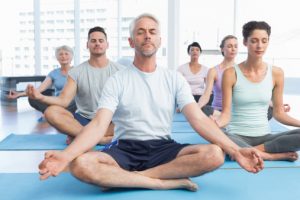
Our eyes are one of the most important organs in the human body, allowing us to view the world around us. However, we often neglect to take care of them, but yoga exercises for eyes aim to improve various disorders that affect eye muscles.
This article will outline many yoga exercises for eye vision improvement that involve moves that utilize the entire body. These are often simple enough to do on your own and at your leisure, right at home or where ever you find the time.
Yoga poses for eyes
- Bhastrika Pranayam: Begin by sitting in lotus position, crossed legged (feet on opposite thighs) with spine erect and head straight. Now using your right thumb, close your right nostril while you exhale forcefully through your left nostril with long inhales and exhales. Repeat this exercise about 20 times on both sides. Finally, finish off the exercise by breathing through both nostrils at once.This exercise can help boost blood circulation to the head, helping to ensure blood is delivered to the eyes, therefore promoting eye health.
- Kapalbhati Pranayama: While sitting in a comfortable position, preferably being supported by a wall, close your eyes and keep your hands in yoga mudra (touching your thumb and finger). Now focus on your lower abdomen as you make quick inhalations followed by powerful and quick exhalations. Inhalations and exhalations should last about one to two seconds each.This exercise helps to cleanse the lungs and improve circulation for better vision.
- Bahya Pranayam: Begin by sitting in the lotus position and inhale deeply, then empty your lungs with a forceful exhalation. Now, while holding your breath, lock your chin with your chest (Jalandhar’s Bandha) and pull your stomach as inwards as it can possibly go (Udhiyana Bandha). After performing these two moves, hold the groin muscles upwards (Mooladhara bandha). Hold all three positions for about 10 to 15 seconds then release with a deep breath.
- Anuloma – Viloma Pranayama: While sitting in the lotus position and resting your palms on your knees, take your right hand and use your thumb to close the right nostril. Now take a deep breath in through the left nostril. Before you exhale, close the left nostril and exhale through the right, which was previously closed. Now, continue by alternating nostrils while you inhale and exhale.
- Shavasana: Also known as corpse pose, and as the name suggests, simply entails lying down on your back with your feet together or apart and hands resting on either side. While performing this, inhale and exhale deeply, allowing your body to relax.
- Palming: Start by rubbing both palms together making them warm. Now place them on your eyes, holding the position for a couple of seconds. This exercise helps to promote relaxation and ease the tension out of your eyes.
- Blinking: Start by opening your eyes as wide as you can then quickly blinking 10 times. Now keep your eyes closed for 20 seconds, then repeat the first step. This exercise helps to promote circulation to the eye muscles and prevents dry eyes.
- Preliminary nose tip gazing: Preformed while sitting in a seated position, then by bringing your right thumb directly in front of your nose. Focus on the tip of your thumb with both eyes, then gradually straighten your arm while still maintaining focus on the thumb.
- Near and distant viewing: While standing straight, focus on the tip of your nose for five to ten seconds then relax. Repeat this exercise about 10 to 20 times.
- Bhramari Pranayama (humble bee breath): Being by sitting cross-legged on the floor, place your fingers over your eyes horizontally. Now exhale slowly, and when inhaling make a buzzing sound, like a bee, while applying light pressure on your eyeballs.This exercise is great for creating calm and improving relaxation by simply breathing in and out.
Yoga can be a great option for those looking to stay healthy and become fit. There are several levels of yoga that can fit your current fitness level. It is recommended to start slow then work your way up to high levels of exercise. If you feel you are ready to try something more strenuous, it may be a good idea to seek the aid of an experienced yoga instructor as they can ensure you are doing exercises correctly and in a safe manner.
Related: Why you should take up yoga, tai chi, and meditation